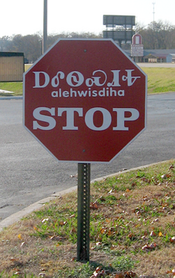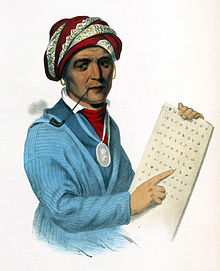|
Cherokee syllabary
The Cherokee syllabary is a syllabary invented by Sequoyah in the late 1810s and early 1820s to write the Cherokee language. His creation of the syllabary is particularly noteworthy as he was illiterate until its creation.[3] He first experimented with logograms, but his system later developed into the syllabary. In his system, each symbol represents a syllable rather than a single phoneme; the 85 (originally 86)[1] characters provide a suitable method for writing Cherokee. The letters resemble characters from other scripts, such as Latin, Greek, Cyrillic, and Glagolitic, however, these are not used to represent the same sounds. HistoryEarly history  Around 1809, impressed by the "talking leaves" of European written languages, Sequoyah began work to create a writing system for the Cherokee language. After attempting to create a character for each word, Sequoyah realized this would be too difficult and eventually created characters to represent syllables. He worked on the syllabary for twelve years before completion and dropped or modified most of the characters he originally created. After the syllabary was completed in the early 1820s, it achieved almost instantaneous popularity and spread rapidly throughout Cherokee society.[4] By 1825, the majority of Cherokees could read and write in their newly developed orthography.[5] Some of Sequoyah's most learned contemporaries immediately understood that the syllabary was a great invention. For example, when Albert Gallatin, a politician and trained linguist, saw a copy of Sequoyah's syllabary, he believed it was superior to the English alphabet in that literacy could be easily achieved for Cherokee at a time when only one-third of English-speaking people achieved the same goal.[6] He recognized that even though the Cherokee student must learn 85 characters instead of 26 for English, the Cherokee could read immediately after learning all the symbols. The Cherokee student could accomplish in a few weeks what students of English writing might require two years to achieve.[7] In 1828, the order of the characters in a chart and the shapes of the characters were modified by Cherokee author and editor Elias Boudinot to adapt the syllabary to printing presses.[8] The 86th character was dropped entirely.[9] Following these changes, the syllabary was adopted by the Cherokee Phoenix newspaper, later Cherokee Advocate, followed by the Cherokee Messenger, a bilingual paper printed in Indian Territory in the mid-19th century.[10] In 1834, Worcester made changes to several characters in order to improve the readability of Cherokee text. Most notably, he inverted the do character (Ꮩ) so that it could not be confused with the go character (Ꭺ).[11] Otherwise, the characters remained remarkably invariant until the advent of new typesetting technologies in the 20th century.[12] Later developments 
 In the 1960s, the Cherokee Phoenix Press began publishing literature in the Cherokee syllabary, including the Cherokee Singing Book.[13] A Cherokee syllabary typewriter ball was developed for the IBM Selectric in the late 1970s. Computer fonts greatly expanded Cherokee writers' ability to publish in Cherokee. In 2010, a Cherokee keyboard cover was developed by Roy Boney, Jr. and Joseph Erb, facilitating more rapid typing in Cherokee. The keyboard cover is now used by students in the Cherokee Nation Immersion School, where all coursework is written in syllabary.[8] In August 2010, the Oconaluftee Institute for Cultural Arts in Cherokee, North Carolina, acquired a letterpress and had the Cherokee syllabary recast to begin printing one-of-a-kind fine art books and prints in syllabary.[14] Artists Jeff Marley and Frank Brannon completed a collaborative project on October 19, 2013, in which they printed using Cherokee syllabary type from Southwestern Community College in the print shop at New Echota. This was the first time syllabary type has been used at New Echota since 1835.[15] The syllabary is finding increasingly diverse usage today, from books, newspapers, and websites to the street signs of Tahlequah, Oklahoma, and Cherokee, North Carolina. An increasing corpus of children's literature is printed in Cherokee to meet the needs of students in Cherokee language immersion schools in Oklahoma and North Carolina.[16] Possible influence on Liberian Vai syllabaryIn the 1960s, evidence emerged suggesting that the Cherokee syllabary of North America provided a model for the design of the Vai syllabary in Liberia.[17] The Vai syllabary emerged about 1832/33. This was at a time when American missionaries were working to use the Cherokee syllabary as a model for writing Liberian languages.[18] Another link appears to have been Cherokee who emigrated to Liberia after the invention of the Cherokee syllabary (which in its early years spread rapidly among the Cherokee) but before the inventions of the Vai syllabary. One such man, Austin Curtis, married into a prominent Vai family and became an important Vai chief himself. It is perhaps not coincidence that the "inscription on a house" that drew the world's attention to the existence of the Vai script was in fact on the home of Curtis, a Cherokee.[19] There also appears to be a connection between an early form of written Bassa and the earlier Cherokee syllabary. DescriptionThe modern writing system consists of 85 characters, each representing a distinct syllable. The first six characters represent isolated vowel syllables. Characters for combined consonant and vowel syllables then follow. The charts below show the syllabary in recitation order, left to right, top to bottom as arranged by Samuel Worcester, along with his commonly used transliterations.[20][21] He played a key role in the development of Cherokee printing from 1828 until his death in 1859. The Latin letter 'v' in the transcriptions, seen in the last column, represents the nasal mid-central vowel, /ə̃/.
Notes: The Cherokee character Ꮩ (do) has a different orientation in old documents, an upside-down letter V, flipped as compared to modern documents.[b] There is also a handwritten cursive form of the syllabary;[26] notably, the handwritten glyphs bear little resemblance to the printed forms. Detailed considerationsThe phonetic values of these characters do not equate directly to those represented by the letters of the Latin script. Some characters represent two distinct phonetic values (actually heard as different syllables), while others may represent multiple variations of the same syllable.[27] Not all phonemic distinctions of the spoken language are represented:
As with some other writing systems, proficient speakers can distinguish words by context. If a labial plosive appears in a borrowed word or name, it is written using the qu row. This /kw/ ~ /p/ correspondence is a known linguistic phenomenon that exists elsewhere (cf. P-Celtic, Osco-Umbrian). The l and tl rows are similarly used for borrowings containing r or tr/dr, respectively, and s (including within ts) can represent /s/, /ʃ/, /z/, or /ʒ/, as indicated in the above word juunsdi̋. Transliteration issuesSome Cherokee words pose a problem for transliteration software because they contain adjacent pairs of single letter symbols that (without special provisions) would be combined when doing the back-conversion from Latin script to Cherokee. Here are a few examples: Ꭲ i Ꮳ tsa Ꮅ li Ꮝ s Ꭰ a Ꮑ ne Ꮧ di itsalisanedi Ꭴ u Ꮅ li Ꭹ gi Ᏻ yu Ꮝ s Ꭰ a Ꮕ nv Ꮑ ne uligiyusanvne Ꭴ u Ꮒ ni Ᏸ ye Ꮝ s Ꭲ i Ᏹ yi uniyesiyi Ꮎ na Ꮝ s Ꭲ i Ꮿ ya nasiya For these examples, the back conversion is likely to join s-a as sa or s-i as si, as the consonant s can be written either with its own isolated glyph, or combined with a following vowel -- but the vowel itself doesn't require being attached to a consonant. One solution is to use a middle dot to separate the two,[28] While some use an apostrophe instead, apostrophes are also used to represent a glottal stop in Cherokee.[29] Other Cherokee words contain character pairs that entail overlapping transliteration sequences. For example:
If the Latin script is parsed from left to right, longest match first, then without special provisions, the back conversion would be wrong for the latter. There are several similar examples involving these character combinations: nahe nahi naho nahu nahv. A further problem encountered in transliterating Cherokee is that there are some pairs of different Cherokee words that transliterate to the same word in the Latin script. For example:
Without special provision, a round trip conversion may change ᎠᏍᎡᏃ to ᎠᏎᏃ and change ᎨᏍᎥᎢ to ᎨᏒᎢ. Character orders There are two main character orders for the Cherokee script. The usual order for Cherokee runs across the rows of the syllabary chart from left to right, top to bottom—this is the one used in the Unicode block. It has also been alphabetized based on the six columns of the syllabary chart from top to bottom, left to right. Numerals Modern Cherokee generally uses Arabic numerals. In the late 1820s, several years after the introduction and adoption of his syllabary, Sequoyah proposed a set of number signs for Cherokee; however, these were never adopted and never typeset.[30] In 2012, the Cherokee Language Consortium agreed to begin using Sequoyah's numerals in some instances.[31] Sequoyah developed unique characters for 1 through 19, and then characters for the "tens" of 20 through 100. Additional symbols were used to note thousands and millions, and Sequoyah also used a final symbol to mark the end of a number.[30][32] The glyphs for 1 through 20 can be grouped into groups of five that have a visual similarity to each other (1–5, 6–10, 11–15, and 16–20).[33] The Cherokee Language Consortium has created an additional symbol for zero along with symbols for billions and trillions.[31] As of Unicode 13.0, Cherokee numerals are not encoded within Unicode.[34] Sequoyah's proposed numeral system has been described as having a "ciphered-additive structure,"[32] using combinations of the characters for 1 through 9 with the characters for 20 through 100 to create larger numbers. For example, instead of writing 64, the Cherokee numerals for 60 and 4 ( Classes Cherokee language classes typically begin with a transliteration of Cherokee into Roman letters, only later incorporating the syllabary. The Cherokee language classes offered through Haskell Indian Nations University, Northeastern State University,[8] the University of Oklahoma, the University of Science and Arts of Oklahoma, Western Carolina University, the University of North Carolina at Chapel Hill, and the immersion elementary schools offered by the Cherokee Nation and the Eastern Band of Cherokee Indians,[35] such as New Kituwah Academy, all teach the syllabary. The fine arts degree program at Southwestern Community College incorporates the syllabary in its printmaking classes.[14] UnicodeCherokee was added to the Unicode standard in September 1999, with the release of version 3.0. The character repertoire was extended to include a complete set of lowercase Cherokee letters as well as the archaic character (Ᏽ). On June 17, 2015, with the release of version 8.0, the Unicode Consortium encoded a lowercase version of the script and redefined Cherokee as a bicameral script. Typists would often set Cherokee with two different point sizes so as to mark beginnings of sentences and given names (as in the Latin alphabet). Handwritten Cherokee also shows a difference in lower- and uppercase letters, such as descenders and ascenders.[36] Lowercase Cherokee has already been encoded in the font Everson Mono. BlocksThe first Unicode block for Cherokee is U+13A0–U+13FF. It contains all 86 uppercase letters, together with six lowercase letters:
The Cherokee Supplement block is U+AB70–U+ABBF. It contains the remaining 80 lowercase letters.
FontsA single Cherokee Unicode font, Plantagenet Cherokee, is supplied with macOS, version 10.3 (Panther) and later. Windows Vista also includes a Cherokee font. Windows 10 replaced Plantagenet Cherokee with Gadugi after the Cherokee language term for "working together".[37] Several free Cherokee fonts are available including Digohweli, Donisiladv, and Noto Sans Cherokee. Some pan-Unicode fonts, such as Code2000, Everson Mono, and GNU FreeFont, include Cherokee characters. A commercial font, Phoreus Cherokee, published by TypeCulture, includes multiple weights and styles.[38] See alsoNotes
References
Bibliography
Further reading
External linksWikimedia Commons has media related to Cherokee script.
|
|||||||||||||||||||||||||||||||||||||||||||||||||||||||||||||||||||||||||||||||||||||||||||||||||||||||||||||||||||||||||||||||||||||||||||||||||||||||||||||||||||||||||||||||||||||||||||||||||||||||||||||||||||||||||||||||||||||||||||||||||||||||||||||||||||||||||||||||||||||||||||||||||||||||||||||||||||||||||||||||||||||||||||||||||||||||||||||||||||||||||||||||||||||||||||||||||||||||||||||||||||||||||||||||||||||||||||||||||||||||||||||||||||||||||||||||||||||||||||||||||||||||||||||||||||

